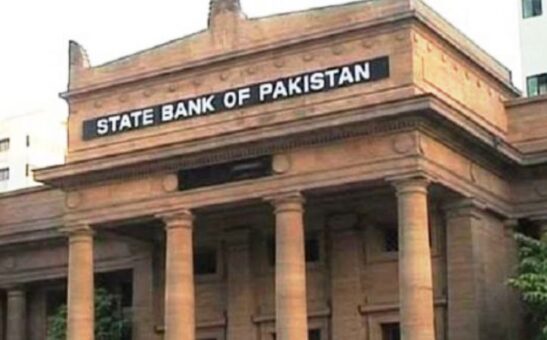KARACHI: The State Bank of Pakistan (SBP) on Monday said that inflation likely to increase due to cost-push pressure from removal of exemptions in the mini-budget and rise in energy tariff.
“Together with low base effects, one-off cost-push pressures from energy tariff increases and the removal of tax exemptions in the Finance (Supplementary) Act are likely to keep year-on-year inflation elevated over the next few months, close to the upper end of the average inflation forecast of 9-11 percent in FY22,” the SBP said while announcing monetary policy for next two months.
The government presented the mini-budget on December 30, 2021. The Finance (Supplementary) Act, 2022 was implemented last week as the ministers of the government repeatedly claimed that removal of exemptions would not affect the lower income group.
READ MORE: Tax imposed to protect domestic entertainment industry
The SBP said that during FY23, inflation is expected to decline toward the medium-term target range of 5-7 percent more quickly than previously forecasted as demand-side pressures wane faster due to the Finance (Supplementary) Act and recent moderation in economic activity indicators.
While headline and core inflation rose in December, both the sequential momentum of inflation and inflation expectations of businesses fell significantly.
“At today’s meeting, the Monetary Policy Committee (MPC) decided to maintain the policy rate at 9.75 per cent, in line with the forward guidance provided in the last monetary policy statement,” the SBP added.
At that time, the MPC had considered the measures taken to lower inflation and keep the ongoing economic recovery sustainable.
READ MORE: FBR slaps sales tax at 17% on supply of food stuff
These measures include a cumulative 275 basis point increase in the policy rate, higher bank cash reserve requirements, regulatory tightening of consumer finance, and curtailment of non-essential imports.
Since the last meeting on 14th December 2021, several developments suggest that these demand-moderating measures are gaining traction and have improved the outlook for inflation. Recent economic growth indicators are appropriately moderating to a more sustainable pace.
While year-on-year headline inflation is high and will likely remain so in the near term due to base effects and energy prices, the momentum in inflation has slowed with month-on-month inflation flat in December compared to a significant rise of 3 percent in November.
READ MORE; FBR enhances tax rates on motor vehicle registration
Inflation expectations of businesses have also declined considerably. The current account deficit appears to have stopped growing since November and the non-oil current account balance is expected to achieve a small surplus for FY22.
Finally, and importantly, the enactment of the recent Finance (Supplementary) Act, 2022 represents significant additional fiscal consolidation compared to the budget and has lowered the outlook for inflation in FY23.
Looking ahead, and against the backdrop of these developments that have improved the inflation outlook, the MPC was of the view that current real interest rates on a forward-looking basis are appropriate to guide inflation to the medium-term range of 5-7 percent, support growth, and maintain external stability. If future data outturns require a fine-tuning of monetary policy settings, the MPC expected that any change would be relatively modest.
In reaching its decision, the MPC considered key trends and prospects in the real, external and fiscal sectors, and the resulting outlook for monetary conditions and inflation.
READ MORE: FBR increases income tax to 15% on cellular services
The economic recovery underway over the last 18 months continues, with its pace moderating from a rebased estimate of 5.6 percent in FY21. Since the last meeting, year-on-year growth rates of several high-frequency demand indicators either stabilized or slowed, including cement dispatches and sales of petroleum products, tractors and commercial vehicles. On the supply side, LSM production decelerated to 3.3 percent (y/y) in July-November 2021, partly reflecting a high base-effect as well as higher input costs, while electricity generation stabilized. Similarly, there has been some easing in the momentum of imports and tax revenue growth. Prospects remain favourable in agriculture, with an improved Rabi crop outlook offsetting reports of lower cotton output. Overall, growth in FY22 is expected around the middle of the forecast range of 4-5 percent, slightly lower than previous expectations in light of moderating demand indicators and higher base effects from the upward revision in last year’s growth rate. Risks to the outlook include, on the domestic front, the current growing Omicron wave and, on the external front, the possibility of faster than anticipated tightening by the US Federal Reserve and geopolitical events in Europe that may have implications for global financial conditions.
Through the first half of FY22, the current account deficit has reached $9 billion. Based on PBS data, imports rose to $40.6 billion, up around 66 percent (y/y), with energy imports and Covid vaccines accounting for more than half the rise. Encouragingly, imports excluding energy and vaccines have stabilized in the last two months. Exports grew by nearly 25 percent (y/y) to reach $15.1 billion, buoyed by record-high shipments of textiles as well as strong rice exports. Meanwhile, remittances rose by 11.3 percent (y/y) to an all-time high of $15.8 billion during the first half of the fiscal year. Looking ahead, the current account deficit is expected to decline through the remainder of FY22, as import growth slows in response to a normalization of global commodity prices and the fuller impact of demand-moderating measures. Indeed, the non-oil current account deficit is less than one-fourth the record levels reached during the first half of FY18. The current account projection is subject to risks on both sides. On the one hand, the deficit could be larger if global commodity prices take longer to normalize. On the other, it could be smaller if the fiscal consolidation associated with the Finance (Supplementary) Act has a faster and more pronounced impact on demand.
READ MORE: FBR issues new FED rates on motor vehicles
During the first half of FY22, FBR tax collections grew strongly by 32.5 percent (y/y). As a result, the fiscal deficit shrank to 1.1 percent of GDP during July-October FY22, compared to 1.7 percent of GDP during the same period last year. The primary surplus also improved by 0.1 percentage points to 0.4 percent of GDP. Looking ahead, with the passage of the Finance (Supplementary) Act that withdraws certain tax exemptions, the fiscal deficit is projected to be around 0.5 percent of GDP lower than previously expected for FY22. Together with recent policy rate increases and accounting for the usual lagged impact of fiscal measures, this additional fiscal consolidation should help further moderate the pace of domestic demand growth, and thus improve the outlook for inflation and the current account in FY23.
During the first half of FY22, private sector credit cumulatively grew by 13.4 percent, largely driven by increased demand for working capital loans especially by rice, textile, petroleum and steel industries. Since the last meeting, both short and long-term secondary market yields, benchmark rates and cut-off rates in the government’s auctions declined significantly, in line with the forward guidance provided by the MPC and the conduct of 2-month open market operations by the SBP.


